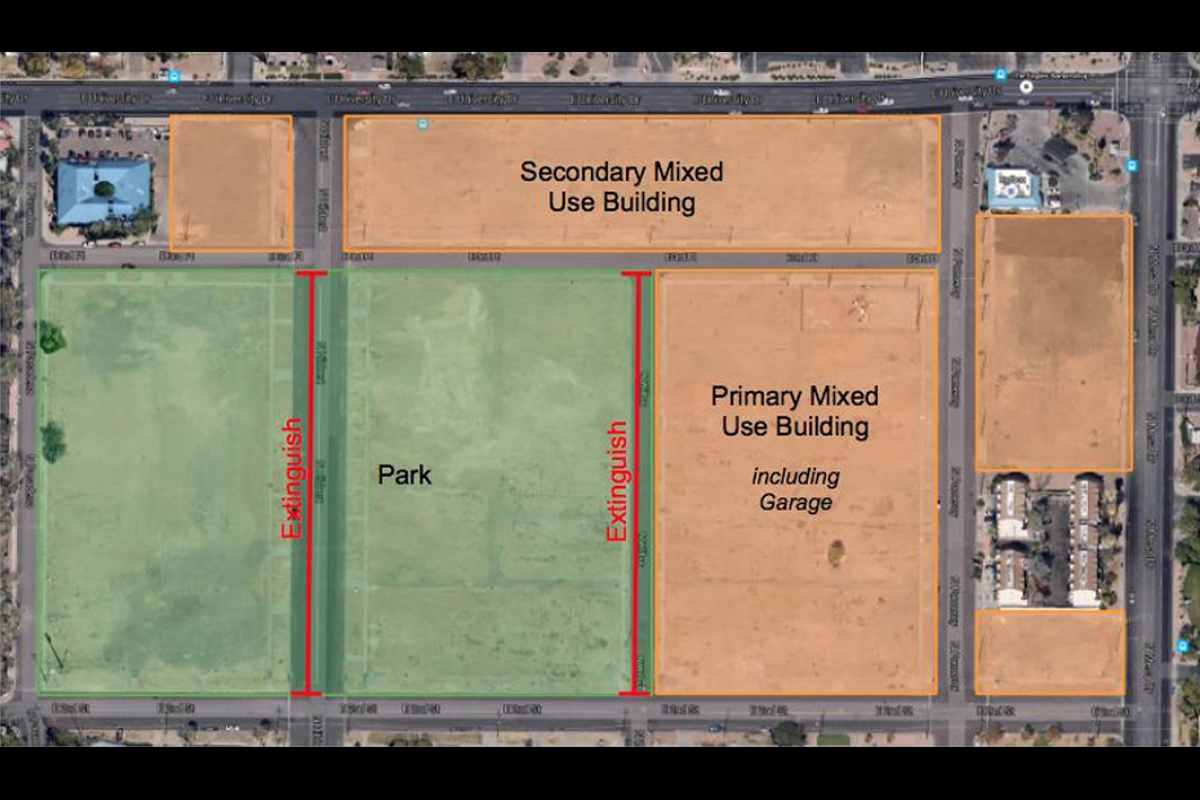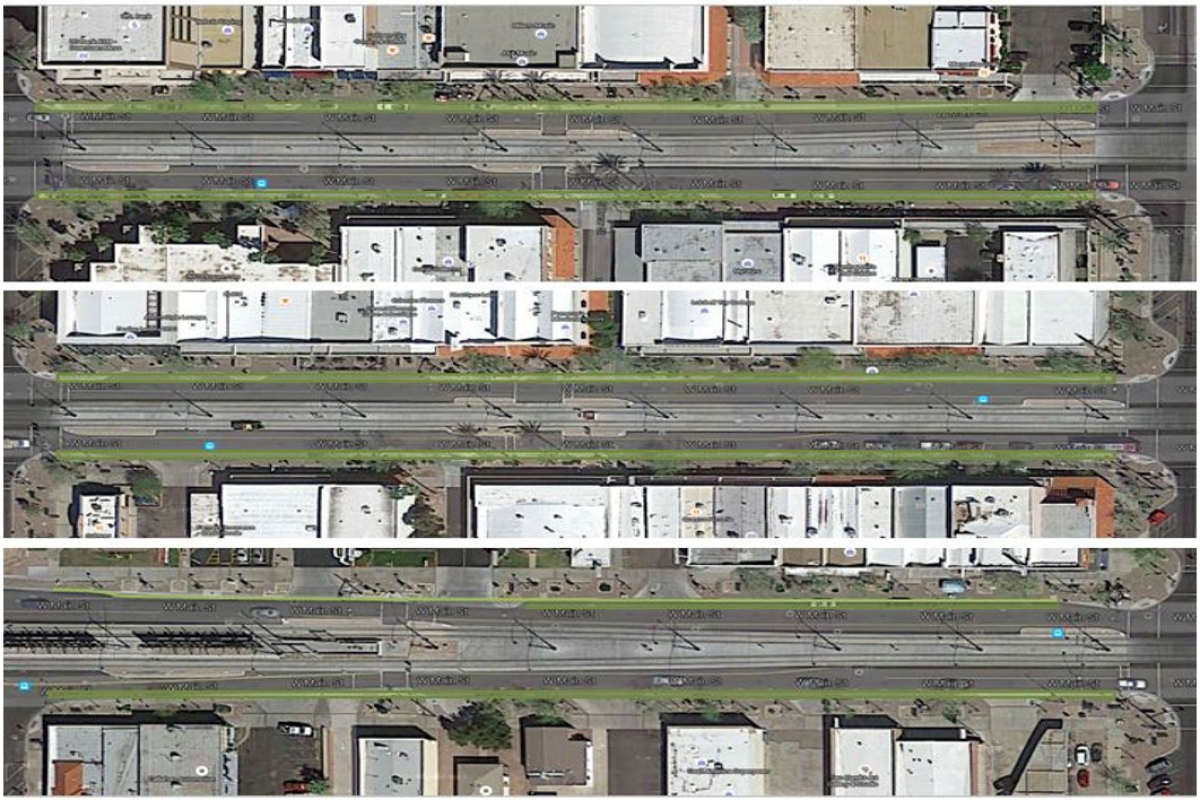Reinventing downtown Mesa:
ASU students develop visions for the city core
[Blogger Notes: Back in February yours truly had the unexpected opportunity to meet and talk off-the-record with some of these ASU students and their urban planning course instructor Lauren Allsopp apart from their "official" guide around the New Urban DTMesa by city employees.
There's a link at the end of this post to read the 69-page original entire report from April
 |
| Jeff McVay [KJZZ interview] |
A lively and enthusiastic group for sure who walked all around getting their eyes opened for opportunities latent in vacant open under-utilized city-owned parcels of land here as well as seeing how certain properties had developed in the past three years.
Unlike the plans for City Center last year where three consultants were paid a total of $75,000 to "come up with ideas", this study report cost the city nothing.]
" . . . the students met with Mesa planning director John Wesley and Jeff McVay, manager of Downtown Transformation. McVay posed the question, “How can we bring people to downtown Mesa — especially Millennials like you?”
Guided by course instructor Lauren Allsopp, the students got to work. They walked the streets of downtown Mesa and Site 17, 30 acres of undeveloped land to the northeast of downtown Mesa. They researched the zoning of the area and learned about its history from Vic Linoff, president of the Mesa Preservation Foundation. Three students — Bailey duBois, Melissa Spriegel and Adenike Opejin — focused on talking with downtown business owners, collecting data about business hours, and learning about the owners’ hopes for the area. Siyuan Han inventoried parking and found that most parking lots are more than 50 percent vacant on weekdays, with an even higher vacancy rate on the weekend, when permit parking and garage parking is open to the public. One Saturday, students surveyed visitors to downtown and found that the majority didn’t live in Mesa and were drawn there by specific events, but often didn’t stay because of the lack of restaurants, safe-feeling public bathrooms and other amenities. With the announcement of a future ASU campus in Mesa, the students decided to undertake a survey of current ASU students.
The more than 70 responses [Question: ONLY 70 out of tens of thousands of ASU students] to the survey helped solidify the group’s own impressions [case of slanting the research to support a conclusion they wanted?]
Students like
- the art components of downtown — installations, sculptures and the Mesa Arts Center
- and also enjoy the pocket parks and light rail.
- the old-town feel
- but many mentioned that businesses closed far too early.
With this background, the students brainstormed ideas, and small groups worked on researching and developing each idea. “It was great working in a small group in this class,” said Samantha Rhea, a student in ASU’s master’s degree program in urban and environmental planning. “Everyone could give input, and we could work together to develop our ideas.”
On April 27, the students presented their ideas to City of Mesa officials and personnel — a group that included the mayor, vice mayor, several council members, and key players in economic development as well as the city’s planning offices. “We were told to allow 20 minutes for questions and comments,” said Rhea — but a lively discussion followed, lasting more than twice that long.
Innovative recommendations
The students’ recommendations ranged from- encouraging temporary land uses in vacant lots [already done]
- revitalizing the city’s broad boulevards by adding walking paths and exercise equipment to the streets’ wide medians. [public safety? Insurance?]
- Temporary land uses can include food trucks, raised garden beds or mobile art. [already done]
- Events such as concerts or outdoor fairs require minimal infrastructure, and can also bring people to areas that are currently unwelcoming.[again, already done, MACFest for a good example, Friday Night's Out]
The students looked at event schedules and saw that Mesa Amphitheatre is only lightly used ?????. [Correction: The Mesa AmpiTheater attracts crowds - it's one of two, the other is the Mesa Convention Center - city-owned venues that turns a profit creating more income than expenses. Museums and MAC have a revenue short-fall of more than 50%, hundreds of thousands of dollars]
Drawing on successful ideas from their home communities, Samantha Rhea, Lauren Black and Andrew Rogge proposed using the amphitheater for low-cost events like movie nights and outdoor exercise classes. ??? [again already done for years! ]
“These are great ideas that make sense from an economic perspective — the revenues from these small events could help fund improvements to the amphitheater,” said McVay. ??
The puzzle of bicycle lanes [hey! It's hot with over 100 days of temps over 100 degrees]
Did these students re-think vehicular traffic patterns, or pedestrian-only zones - really no need to park on main Street-all businesses have entrances and parking lots in the back of buildings]
A more controversial recommendation centered on making downtown more bicycle-friendly. Seeing the expanses of parking lots behind business buildings, Opejin proposed replacing Main Street’s on-street parking with protected bike lanes — a safer option than the shared bike/auto lanes that now occupy the street. This proposal generated a good amount of discussion at the April 27 meeting. McVay explained that the city is working on a less disruptive approach: creating bike lanes on streets just north and south of Main Street. The students argued for taking a long-range view — that bike lanes on Main Street may make sense in a future world of driverless cars and more non-auto transportation. “This is a great example of the value of student projects like this,” said McVay. “The students have fresh perspectives that challenge the status quo and can enlighten us.”
Mayor Giles responded with enthusiasm, too. “The presentations touched on several ideas that staff is currently exploring, and to me that was validation that we are on the right track to recapturing the true potential of downtown,” he said. “The students’ emphasis on bringing more people downtown and keeping them here longer was key. “It was great to get the students’ perspectives on how we can move downtown Mesa to the next level.” When ASU students begin to find their way to downtown Mesa in larger numbers if - that's a very big if - a satellite campus establishes itself there, downtown will change — no doubt in some of the ways envisioned by the urban planning students. “I really think people should go to Mesa. It’s worth taking a look!” said Rhea.
“Reinvent Downtown Mesa” was a project of PUP 494/561, Urban Design Workshop, a course taught by affiliate faculty member Lauren Allsopp. Students enrolled in the course were Lauren Black and Andrew Rogge (BS in Urban Planning) and Dian Chen, Bailey DuBois, Siyuan Han, Adenike Opejin, Samantha Rhea, Melissa Spriegel and Kezhen Wang (Master of Urban and Environmental Planning).
The complete report is available here.
The course is an offering of ASU’s School of Geographical Sciences and Urban Planning, an academic unit of the College of Liberal Arts and Sciences.
School of Geographical Sciences and Urban Planning
480-965-7449 BTL@asu.edu







No comments:
Post a Comment